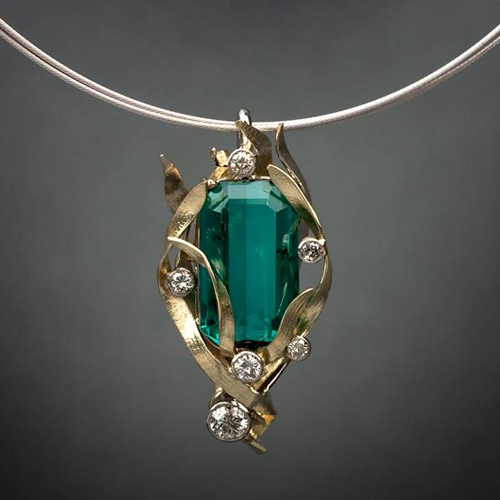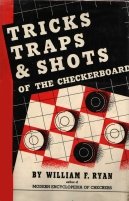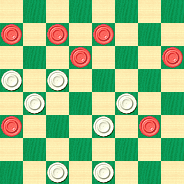The Checker Maven
Jump to navigationAnother Heffner Gem

The term "gem" is often used to describe a particularly elegant checker problem; we've discussed this at various times and at various length in previous editions of The Checker Maven. What qualifies as a "gem" is highly subjective, and seems to fall into the "I'll know it when I see it" category. Now, there is no doubt the elegant piece of jewelry shown above is a "gem" in more than one sense of the word. Whether or not today's excerpt from Willie Ryan's Tricks Traps & Shots of the Checkerboard falls into the "gem" category is something you'll have to decide for yourself, after Willie sets the stage for us.

"Back in 1925, when I was learning checkers the hard way, I played the following game in a 30-game match with Mike Lieber, of Detroit, then one of the country's leading players:
| 10-14 | 27-24 | 11-16 | |
| 22-17 | 3- 7 | 24-20 | |
| 6-10 | 24-19 | 17-21 | |
| 17-13 | 11-16 | 20-11 | |
| 1-6 | 20-11 | 7-i6 | |
| 25-22 | 8-24 | 26-22 | |
| 14-17 | 28-19 | 16-20---A,1 | |
| 21-14 | 4-8 | 22-17 | |
| 9-25 | 22-18 | 20-24 | |
| 29-22 | 14-17 | 18-14 | |
| 10-14 | 32-27 | 2-7, | |
| 24-20 | 8-11 | reaching the | |
| 7-10 | 27-24 | diagrammed | |
| position." |

WHITE
White to Play and Win
W:W31,30,23,19,17,14,13:B24,21,12,10,7,6,5.
A---The losing move. 10-14 will insure a draw with a little care."
1---It seems somewhat unintuitive that going in for a king would lose, yet it indeed does. We ran a computer analysis, and it was interesting to see the computer start out by evaluating this as a weak move, but, as it ran deeper and deeper searches, downgrading the move to a highly probable loss. We can easily understand how a human player, even of Mr. Ryan's strength, could make this move---Ed.
We find Willie's comment, by the way, about "learning checkers the hard way" to be very revealing: if Willie learned "the hard way" then we suspect that all the rest of us learn the same way. Alas, there is no royal road to checker success--- but where would the fun be if there was?
In any event, see if you can find that sparkling, precious winning way, and then click on Read More to see all the facets of the solution.![]()
Solution
"From diagram on previous page, white wins by: 23-18*---B, 24-28, 31-27* 28-32, 27-24, 32-27, 24-20, 27-24, 18-15, 24-27, 20-16, 27-24, 13-9*!, 6-22, 15-6, 24-15, 6-2, 12-19, 2-25, 19-23, 25-22, etc---3.
B---Here, Lieber went 31-26---2, 24-27, 19-16, etc., and only drew. After the game, I pointed out that 23-18 would win, forcing black into a startling stroke, first shown by A. J. Heffner over 60 years ago, from a different opening and order of moves."
2---Actually, computer analysis shows that 31-26 is indeed good for the win and, for reasons we don't quite understand, rates it a stronger move than Willie's starred 23-18, showing this line of play: 31-26 24-27 19-16 12-19 23-16 and now if 27-32 (27-31 no better) then 26-22 32-27 16-11 7-16 14-7 16-19 22-18 19-23 7-3 27-31 3-7 31-26 18-14 26-31 14-9 5-14 17-1 White Wins. Mr. Lieber must have lost the thread of play somewhere in the actual game.
3---White wins with the move.
So, is this one a gem? The unintended dual solution leads us to think that, while it's a great problem, it may be a bit short of the "gem" class. If you're so inclined, let us know what you think.

You can email the Webmaster with comments on this article.
